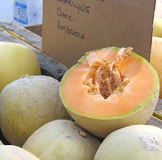Melons

What would a slice of prosciutto be without the sweet juice of cantaloupe? Or a summer’s night without the refreshing finish of sliced honeydew? Or a picnic without the crescent smile of a ripe watermelon?
The melon has tempted taste buds since the reign of Egyptian pharaohs. Some of its earliest appearances include pre-biblical paintings as well as the imperial menus created by Apicius, Rome’s very own Julia Child. The fruit made its way to the American palate in colonial times and was later cultivated in California by the Spanish.
These thick-rinded, sweet-fleshed fruit are divided into two categories: muskmelons and watermelons. Muskmelons include familiar varieties such as cantaloupe, casaba, and honeydew. Most people don’t know that melons belong to the same gourd family as winter squash, cucumbers, and pumpkins. Although referred to as a fruit, melons are also recognized as a “culinary vegetable,” and can be prepared like their more savory cousins. Nontraditional melon preparations include tomato and watermelon salad, melon gazpacho and melon salsa. All parts of the melon can be consumed: African and Indian cultures often ground or roast melon seeds, and even the rind can be enjoyed by pickling or preserving.
Farmers Market Tip: To pick the perfect melon, listen for a hollow sound when you knock on it, check for softness at the vine end, and make sure you smell a sweet odor.

